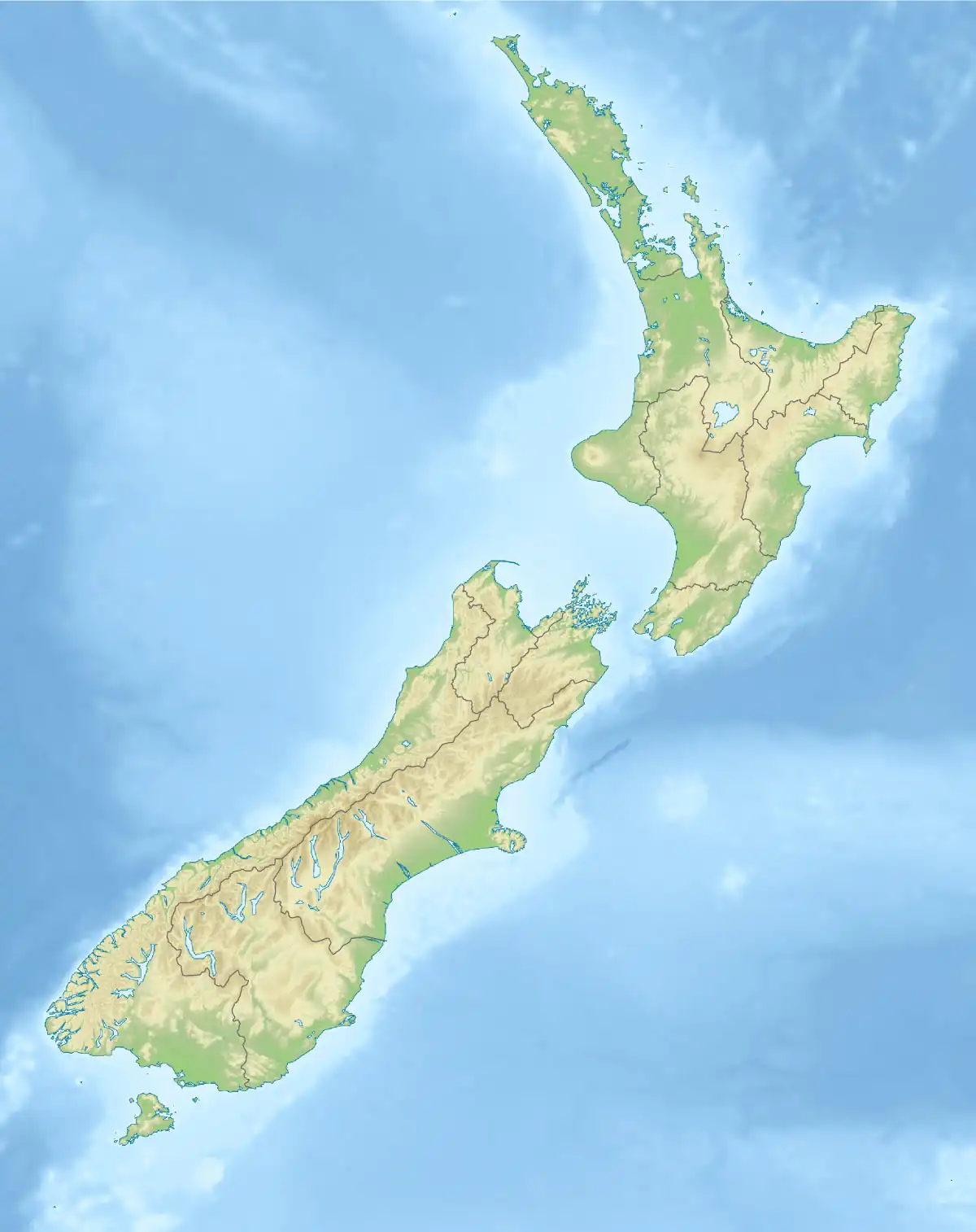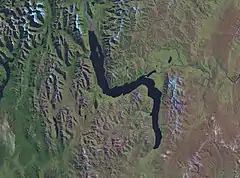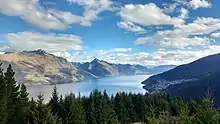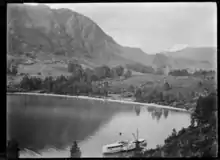Lake Wakatipu
Lake Wakatipu (Māori: Whakatipu Waimāori) is an inland lake (finger lake) in the South Island of New Zealand. It is in the southwest corner of the Otago region, near its boundary with Southland. Lake Wakatipu comes from the original Māori name Whakatipu wai-māori.[1]
| Lake Wakatipu | |
|---|---|
| Whakatipu Waimāori | |
 Lake Wakatipu and The Remarkables | |
 Lake Wakatipu Lake Wakatipu is in the Otago Region of the South Island. | |
| Location | Queenstown-Lakes District, Otago Region, South Island |
| Coordinates | 45°3′S 168°30′E |
| Lake type | Glacial lake |
| Native name | Whakatipu Waimāori (Māori) |
| Primary inflows | Dart River / Te Awa Whakatipu, Rees River |
| Primary outflows | Kawarau River |
| Catchment area | 2,674 km2 (1,032 sq mi) |
| Basin countries | New Zealand |
| Max. length | 75.2 km (46.7 mi) |
| Max. width | 5 km (3.1 mi) |
| Surface area | 289 km2 (112 sq mi) |
| Average depth | 130 metres (430 ft) |
| Max. depth | 420 metres (1,380 ft) |
| Water volume | 37.57 cubic kilometres (9.01 cu mi) |
| Residence time | c. 12 years |
| Surface elevation | 310 m (1,020 ft) |
| Islands | Pig Island, Pigeon Island, Tree Island & Hidden Island. |
| Settlements | Kingston, Queenstown, Glenorchy |
With a length of 80 kilometres (50 mi), it is New Zealand's longest lake, and, at 289 km2 (112 sq mi), its third largest. The lake is also very deep, its floor being below sea level (−110 meters), with a maximum depth of 420 metres (1,380 ft). It is at an altitude of 310 metres (1,020 ft), towards the southern end of the Southern Alps / Kā Tiritiri o te Moana. The general topography is a reversed "N" shape or "dog leg". The Dart River / Te Awa Whakatipu flows into the northern end, the lake then runs south for 30 kilometres before turning abruptly to the east. Twenty kilometres (12.4 mi) further along, it turns sharply to the south, reaching its southern end 30 kilometres (19 mi) further south, near Kingston.
The lake is drained by the Kawarau River, which flows out from the lake's only arm, the Frankton Arm, 8 km (5.0 mi) east of Queenstown. Until about 18,000 years ago the Mataura River drained Lake Wakatipu. The Kingston Flyer follows part of the former river bed now blocked by glacial moraine.[2] Queenstown is on the northern shore of the lake close to eastern end of its middle section. It has a seiche period of 26.7 minutes which, in Queenstown Bay, causes the water level to rise and fall some 200 millimetres (8 in).[3]
Lake Wakatipu is known for its scenery and is surrounded by mountains. Two mountain ranges, the Remarkables and the Tapuae-o-Uenuku / Hector Mountains, lie along its southeastern edge. It is a common venue for adventure tourism, with skifields, paragliding, bungy jumping and tramping tracks within easy reach. A vintage steamboat, the TSS Earnslaw regularly plies its waters. Several vineyards are nearby in Gibbston.


Etymology
The full original name of the lake is Whakatipu-wai-Māori.[4] While the lake lacks an official name,[5] it is generally referred to as "Lake Wakatipu".[4]
The name is believed to originate from the Waitaha people, who were later displaced by Kāti Māmoe. Elders from the modern iwi Ngāi Tahu say that while the name Whakatipu is archaic and its original meaning is a mystery, whaka means causative and tipu means growth.[4] Wakatipu could mean "growing bay" if the original was Whakatipu and the h elided as a result of the Southern Māori dialect.[6] The dialect is also known for dropping final vowels. Waka can also mean 'hollow'.[6] Wakatipua or Whakatipua (Canoe/Bay of spirits) have been recorded historically, as has Wakatapu (sacred vessel).
A legend says that the lake bed was formed when a giant ogre, Kopu-wai, was burned while lying asleep, leaving only his heart behind, which according to the same legend is the cause of the rhythmic rise and fall of the lake's seiche. A variation on that is that Wakatipu is a contraction of Waka (trough) and tipua (enchanted giant), the giant was burnt when the surrounding bush was lit and his breathing causes the seiche. Another possibility, if the name was Whakatipu (make grow), is that a defeated group regrew their strength here.[7]
Whakatipu is also the name of another six unrelated geographical features in the South Island, including Tarahaka Whakatipu, the Harris Saddle at the head of the Routeburn Track; Te Awa Whakatipu, the main Dart River / Te Awa Whakatipu flowing into the lake; Whakatipu Katuka, the Hollyford River and Valley; and Whakatipu Kohurangi, Māori Bay in Pelorus Sound / Te Hoiere, Marlborough.[8]
Flooding
Lake Wakatipu has experienced periodic flooding [9] affecting the lakeside communities of Kingston, Glenorchy and Queenstown. Notable flooding events include the 1878 Queenstown floods, which affected a large part of the outlying Queenstown and Otago areas, the 1995 Queenstown floods, and most notably the 1999 Queenstown floods, which significantly damaged the Queenstown CBD and road infrastructure resulting in approximately $50 million worth of damage.[10][11][12]

Wildlife
Lake Wakatipu is a habitat for the longfin eel (a specimen caught in 1886 is the largest known of this species[13]), and for introduced brown trout, salmon and rainbow trout.[14] These and other fish support predators such as the pied shag. The black-billed gull is often found around the lake while the most common birds are the black-billed gull and the introduced mallard. A smaller bird often not noticed because of its size is the New Zealand scaup.
In popular culture

Film
Lake Wakatipu doubled as the Scottish Loch Ness in the 2007 film The Water Horse: Legend of the Deep.[15]
The lake was a backdrop for several scenes in The Lord of the Rings: The Fellowship of the Ring, including Amon Hen.
Television
Lake Wakatipu is the eponymous lake in the murder mystery television series Top of the Lake (2013).[16]
Sports
See also
References
- "Māori name for Lake". Archived from the original on 20 December 2012. Retrieved 9 June 2012.
- Turnbull, I M (2000), Geology of the southeastern Eyre Mountains relevant to tenure review (PDF), Wellington, N.Z.: Department of Conservation, ISSN 1171-9834
- "Lake Wakatipu at Willow Place". www.orc.govt.nz. Retrieved 31 May 2019.
- Kuprienko, Dasha (5 December 2017). "Is it Wakatipu or Whakatipu?". Stuff. Retrieved 17 January 2021.
- "Place name detail: Lake Wakatipu". New Zealand Gazetteer. New Zealand Geographic Board. Retrieved 13 August 2021.
- H. Beattie (1920). "Art. XII.—The Southern Maori, and Greenstone: Addenda". Transactions and Proceedings of the Royal Society of New Zealand. 52: 51–52.
- "NZGB Gazetteer". gazetteer.linz.govt.nz. 15 April 2013. Retrieved 26 May 2023.
- Jamieson, Debbie (16 January 2021). "Call to return the missing 'wh' to South Island Māori place names". Stuff. Retrieved 17 January 2021.
- "Lake Wakatipu flood hazard (ORC)" (PDF).
- "Flood events 1995–2004". www.civildefence.govt.nz. Retrieved 31 May 2019.
- Williams, Guy (15 November 2014). "Learning from the big flood". Otago Daily Times Online News. Retrieved 31 May 2019.
- "Back in the Day: Queenstown hit by extreme flooding". TVNZ. Retrieved 31 May 2019.
- Fishing World Records
- "Lake Wakatipu Fishing". Archived from the original on 20 December 2014. Retrieved 28 April 2011.
- Miller, Gerri. "Inside 'The Water Horse'". HowStuffWorks, Inc. Retrieved 7 July 2008.
- Lane, Megan (17 August 2013). "Top of the Lake: Is New Zealand's greatest actor New Zealand itself?". BBC News Magazine.
- Lacy, Judith (21 February 2012). "Southern Everest knocked off". Stuff.
- Dodgshun, Joe (7 February 2012). "First person to swim Lake Wakatipu". Otago Daily Times Online News.
External links
- Lake Wakatipu information at the NZ Department of Conservation